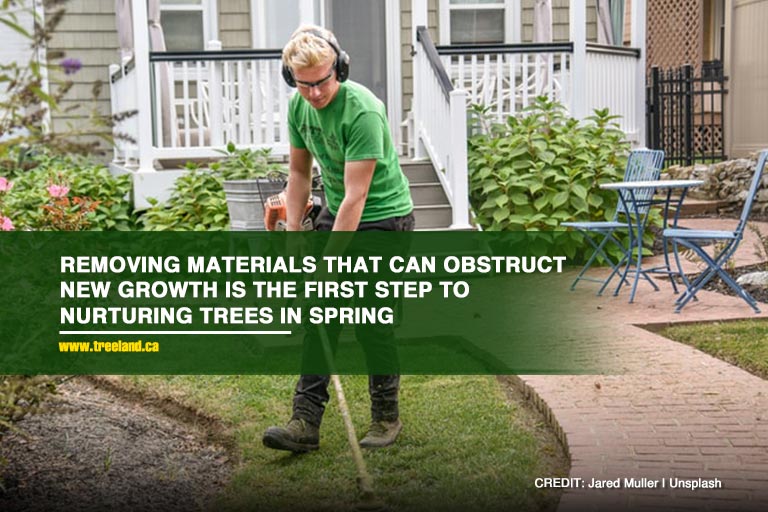There are two types of trees that thrive in cold countries like Canada — deciduous and coniferous. Deciduous trees, also known as broadleaf trees, are the type to lose their leaves in the winter. Coniferous trees do not lose them. While deciduous trees have different shapes and colours of leaves, coniferous ones have “needles” that stay on throughout the year which gained them the name “evergreen”. When planning to add Caledon trees to properties, choosing adaptable species should be on top of yourmind. With springtime just around the corner, property owners also need to prepare their trees.
When considering the health of ornamental trees and shrubs, the first thing that comes to mind is insects and diseases. However, one of the biggest factors that can affect the overall health of trees is the weather.

In Canada, extremely cold weather can be experienced which demands property owners to know basic tree care tips for the winter season. Plants — even full-grown trees — can suffer from winter injury as a result of this drop in temperature. A common winter injury in trees is excessive drying. This happens when water is not replaced since the roots cannot take up enough water. The cold temperature is bad enough but it also makes trees more vulnerable to secondary or opportunistic pests.
Aside from drying, some deciduous trees will develop dead areas in the bark. Most of these would begin to peel away from the trunk as the weather starts getting hotter. If this happens, the trees will fail to leaf out properly in the spring. Sometimes, there are leaves that would grow but they will suddenly wilt and begin to die when the temperature gets warmer.
How Trees Prepare for Spring
The growth cycle of trees in Canada is affected by the changing seasons. The extreme fluctuations in temperature pushed trees to develop some specialized defence mechanisms to survive winter. With the help of reliable Caledon tree services, property owners can start preparing trees for the changing season.
When it’s winter, people will protect themselves by wearing thermal clothes but trees can’t do that. Instead, trees rely on different adaptations that allow them to survive very cold temperatures.
When temperatures start to drop, changes in the trees can be observed. The bark, for instance, is the first line of defence against the cold and provides insulation for the tree. It acts as a wall that keeps everyone inside warm and toasted even if the world outside is already freezing.
Another important adaptation of trees is keeping water in during the cold months. In the leaves, a process called transpiration happens. It is when oxygen gas and water vapour leave the tree through the stomata when water is pulled up from the roots through the xylem. The leaves of deciduous trees will fall — a process called abscission — in order to keep the leaves from wasting water in the transpiration process. Even if the ground is frozen, the tree can still get an ample supply of water when it loses its leaves.
Coniferous trees have a different adaptation:
- They have long and thin needles so there is a small surface area and fewer stomata to lose water.
- The stomata are not on the surface of the needle thus creating a pocket of still air that results in less transpiration.
- The needles have thick and waxy cuticles that help prevent water loss.
Like how some animals prepare for winter, trees also prepare for the winter through dormancy. This is a time when the tree’s metabolism is slowed down to conserve as much energy as possible.
How to Prepare Trees for Spring

As the snow thaws and melts, plants around a property should also prepare to embrace the sun and grow. For property owners who are yet to fill their lawns and gardens with plants, spring is considered a good time to plant a tree. To get started, here are the steps that tree services in Caledon take:
- Inspect the landscape and trees
A simple inspection of the area is not enough. There could be standing water in low spots, broken branches, and pest infestation. In some cases, after the snow is cleared, property owners will realize that they need the help of tree removal services in Caledon. Familiarizing your property and landscape will make it easier to identify issues.
- Clean Up
Like how closets are cleaned up to make room for new clothes in spring, landscapes should be, too. Trimming small trees and shrubs, removing fallen trees, cleaning up leaves and debris to make room for emerging plants from the soil and leafing out are simple steps to welcome plants back. Use this opportunity to gather materials for a compost pile that can add organic matter back to the soil.
- Gear up for Spring Storms
According to The Weather Network, Canadians will expect this year’s Spring to be more volatile. It is expected that the weather pattern in the country will be difficult for trees especially when there are spring storms. Expect that weak tree branches will break and cause property damage. Gear up ahead of time and check in with your preferred tree service in Caledon, Ontario for printing and other preparations.
- Plant New Trees
Spring is the best time to plant new trees. Think of how you wish to transform your property by adding new tree species or by replacing fallen ones. Consult with professionals to determine the right trees to add to your property.
- Mulching Landscape Beds and Trees
Spring is the best time to apply a new layer of mulch to a landscape. It can help freshen up the look of the garden, prevent weed seeds from germinating, and regulate the temperature of the soil during the summer season. Adding natural mulches can also help add organic matter to the soil to also nourish the plants.
- Fertilize Trees
Trees and lawns will be using reserved resources for new root growth and leaves when the weather starts to feel warmer. In spring, they will need more nutrients to support the new growth. The best care for trees begins by nourishing them. Aside from supporting their growth, it can also equip trees against pests, diseases, and weather changes.
Spring is here and this is the best time to get more greens to surround your property. Contact Caledon Treeland today at (905) 880 1828 to avail of tree services for your home and commercial spaces.


